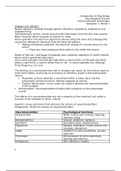Introduction to Psychology
Psychological Science
Vrije Universiteit Amsterdam
Semester 1, Period 1
Chapter 3 (p. 69-101)
Neural networks: develop through genetic influence, maturation, experience and
repeated firing
Somatosensory nerves: nerves that provide information from the skin and muscles
Motor neurons: direct muscles to contract or relax
Action potential: the electrical signal that passes along the axon and subsequently
causes the release of chemicals from the terminal buttons
Resting membrane potential: the electrical charge of a neuron when it’s not
active
There are more potassium than sodium ions inside the neuron
Nodes of Ranvier: small gaps of exposed axon, between segments of myelin sheath,
where action potentials take place
All-or-none principle: the principle that when a neuron fires, it fires with the same
potency each time; a neuron either fires or not – it cannot partially fire, although
firing frequency can vary
The binding of a neurotransmitter with a receptor can cause ion channels to open or
close more tightly, producing an excitatory or inhibitory signal in the postsynaptic
neuron
Reuptake: process whereby a neurotransmitter is taken back into the
presynaptic terminal buttons, thereby stopping its activity
Enzyme deactivation: occurs when an enzyme destroys the neurotransmitter
in the synapse
Autoreception: neurotransmitters binding with receptors on the presynaptic
neuron
The effects of a neurotransmitter are not a property of the chemical, but rather a
function of the receptor to which it binds
Agonists: drugs and toxins that enhance the actions of neurotransmitters
Antagonists: inhibit the actions of neurotransmitters
Neurotransmitter Psychological functions
Acetylcholine Motor control over muscles, learning,
memory, sleep
Norepinephrine Arousal, attention, vigilance
Serotonin Emotional state, impulsiveness
Dopamine Reward, motivation, motor control over
voluntary movement
GABA Inhibition of action potentials, anxiety
reduction
Glutamate Enhancement of action potentials,
learning and memory
Endorphins Pain reduction, reward
1
,Broca’s Area: small portion of the left frontal region of the brain crucial for the
production of language
Wernickes area:
Psychophysiological assessment: examination of how bodily functions change in
association with behaviors or mental states
EEG: measures electrical activity in the brain > imprecise to inspect specific
responses to particular stimuli
ERP: provides information about the speed at which the brain processes
events but not about where in the brain these processes take place
Brain imaging methods
Positron emission tomography (PET): assesses metabolic activity by using a
radioactive substance injected into the bloodstream
Magnetic resonance imaging (MRI): uses a powerful magnetic field to produce
high-quality images of the brain > detection of brain damage and tumors
Functional magnetic resonance imaging (fMRI): used to examine changes in
the activity of the working brain by measuring changes in the blood’s oxygen
levels
Transcranial magnetic stimulation (TMS): use of strong magnets to briefly
interrupt normal brain activity as a way to study brain regions
Brain stem: houses structures that control functions associated with survival, such
as heart rate, breathing, swallowing, vomiting, orgasm
Reticular formation: projects up into the cerebral cortex and affects general
alertness and sleep
Cerebellum: large protuberance at the back of the brain stem important for motor
learning and motor memory
2
, Subcortical regions – some of which belong to the limbic system
Brain structures in this system are especially important for controlling
appetitive behavior and emotions
Thalamus: gateway to the brain which receives incoming sensory information
before it reaches the cortex
Hypothalamus: regulation of bodily functions; temperature, blood pressure,
glucose and basic motivation
Hippocampus: associated with formation of memories
Amygdala: serves a vital role in learning to associate things with emotional
responses and in processing emotional information
Basal ganglia: system of structures that are important for the planning and
production of movement and experiencing reward
Cerebral cortex: outer layer of brain tissue and brain surface; site of thoughts,
perceptions and complex behaviors
Corpus callosum: bridge of millions of axons which connects the hemispheres and
allows information flow between them
Occipital lobes: devoted to vision
Primary visual cortex: major destination for visual information
Parietal lobes: important for the sense of touch and for the attention to the
environment
In each lobe, information is directed to the primary somatosensory cortex
3





